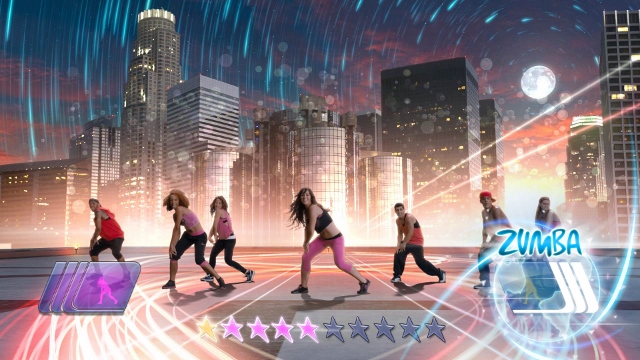It’s … well, never when we’re excited to see a new fitness video game. (Surprise: We’re not in this line of work to get in shape.) But the PR rep knew what he was doing when he pitched us this: Check out Zumba Fitness World Party … for Xbox One. Oh, a press demo to see a next-generation product, you say? Let us slap on our leotards.
Zumba Fitness World Party is the upcoming edition in the series of exercise games based on dancing with international flair (mainly Latin but other styles such as Irish and Polynesian will be included). Publisher Majesco will release it at the end of the year for Wii U, Wii, Xbox 360, and yes, the successor to the 360, the Xbox One.
We got an early preview of World Party. And while we’re sure the game would help us melt off more of that “more to love” business around our waists than the same amount of time spent on Halo 4, that wasn’t exactly what we were interested in. Who cares about living a healthy and active lifestyle! Let’s use this opportunity to take a peek into the benefits and challenges of making games on Microsoft’s next system.
Graphics
For some very odd reason, Majesco’s Xbox One development kit wouldn’t work on our office HDTV, even though this particular developers-only console worked everywhere else it went on this press tour. (Our television works just fine otherwise, too.) So we didn’t get to see for ourselves how World Party’s graphics compared between the Xbox 360 and Xbox One versions.
If you’re willing to take Majesco’s word for it, however, then the extra horsepower in the Xbox One does matter when it comes to looks. “Dramatically better,” Majesco’s chief technology officer and head of development Kevin Ray told GamesBeat when we asked about the visual difference. “With the Xbox One, we were able to keep every element separate and stored with minimal compression. There’s no artifacting from compressing elements, there are no hiccups from rate conversions, there’s no up-sampling between any surface and the final display resolution. Everything that’s assembled into the final image was stored at the highest possible quality.”
And this is just the start, of course. Developers only recently got a hold of the Xbox One and are still figuring things out. We should see even more exciting things in the future. “We learned a lot during this project and already have some pretty amazing ideas in mind for the next product,” said Ray. “Xbox One is some pretty amazing kit.”
Mr. GamesBeat HDTV doesn’t agree, but maybe that’s just him.
Speed
No doubt consumers will be looking for better graphics in a pricey $500 next-gen console — whether they find enough of an improvement in the Xbox One over its predecessor is another story. But the hardware will also offer other benefits, including some you may not even notice.
“The system is very quick,” said Ray. “Not just [CPU] clock speed but the interface and the whole experience of kicking something in to play. At first it’s not noticeable, but when you go back to any other platform and realize how much time is wasted waiting for this or that, it’s just brutal. The Xbox One is frictionless for getting into a game.”
The new Kinect
For now, it’s not “Kinect 2.0” or “Kinect One” — Microsoft is calling the updated motion-sensing camera for Xbox One just “the new Kinect” (yes, we checked — that’s currently the official name). The company has been touting the device’s huge increase in accuracy over the current version on the Xbox 360. New Kinect can catch more subtle movements and see more points of movement. That’s a good thing, but it doesn’t come without headaches for third-party developers. For makers of a dance-workout game in particular, the camera can be a little too good.
“Precision is great,” Majesco executive producer Lisa Roth told GamesBeat. “And for many other applications, [the new Kinect] would be amazing. But for us, Zumba isn’t about accuracy. It’s not about getting every single move totally right.”
The new Kinect could be punishing to players who don’t get every hip thrust down perfectly, so the developers actually have to rein in the camera’s super vision. “We want to find that sweet spot in gesture-data recognition where players keep wanting to work out and keep playing, so they don’t feel defeated,” said Roth.
No one at Majesco, however, is really complaining. In their eyes, it seems what the new Kinect offers outweighs the extra development work required. “The user experience is just perfect,” said Ray. “With previous motion-based sensing systems, developers have been forced to design their [user interface] around the constraints of the [input/output] device. With Kinect 2.0, there’s an unbelievable amount of power under the hood. It’s ridiculously low latency. It has a much better view area — it seems to work in every room we’ve tested no matter how small. It’s impervious to sunny windows or unlit rooms at night. The skeletal data is a bit better.”
Bottom line for Majesco? “It’s much better than Kinect 1.0,” said Ray.
By the way, you might wonder why “unlit rooms at night” is even a consideration, but it does matter to the makers of a dance game. “When the lights are bright, and you’re dancing in front of your peers, sometimes there are some inhibitions,” said Roth. “If you’re having a party in your living room with as many people as you can jam in, maybe you want to turn the lights down and lose some of your inhibitions. [The new Kinect needs less] light, so that’s great.”
Apologies to parents of teenagers who just had to read that.

